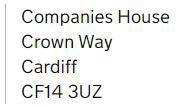What is a Compulsory Strike-Off?
Companies House require limited entities to oblige by their filing requirements and to comply with the most recent edition of the Companies Act 2006 which is set out to govern all limited entities incorporated in the UK to ensure that they all comply with the same set of simple laws that make it easier to run your business.
If these laws and filing requirements are not met Companies House reserve the right to strike a limited entity off of the register, therefore giving it the legal right to make it a dissolved company. This act is called a Compulsory Strike-Off. Companies House can have your limited entity struck-off if it has failed to abide by its legal requirements. Some of the common causes for compulsory strike-off are:
- Failure to submit the Annual Accounts on time
- Failure to submit an annual confirmation statement
- Failure to conform to legal requirements
- The company failing to appoint a company director(s)
- The company has ceased active trading
It should be noted that the above are the most common reasons for a limited company to be put forth for a compulsory strike-off but these are not the only reasons for a limited company to be eligible for a compulsory strike-off.
The best way to avoid this is by keeping up to date with all of the company's filing deadlines and to ensure that the company keeps Companies House well informed of any changes to the company, such as changes to the company registered address updated immediately with Companies House.
How Would I Know If Companies House Have Started The Compulsory Strike-Off Process?
When Companies House are beginning the compulsory strike-off process they will follow the outlined statutory process to ensure that the all parties with an invested interest in the compulsory strike-off are made aware and have ample time to object to the compulsory strike-off.
A possible reason for a related party to object to a strike-off is if the company being struck-off owed them money, therefore requiring the company not to be struck-off.
When Companies House are processing a compulsory strike-off they would follow the steps outlined below. If the company that is being struck-off does not take any action against these steps then the compulsory strike-off will proceed.
Step 1 - Letter of Warning
Firstly, Companies House will inform the company by sending two letters of warning to the registered address of the company that is to be struck-off. Within these letters Companies House will inform the company directors of the reason for the compulsory strike-off and how they can rectify this action.
The letter will often inform the business in question of Companies House's intent for the company to be struck-off from the register.
Step 2 - Publish the First Gazette Notice
After the letters have been sent and Companies House has received no correspondence from the company being struck-off, informing Companies House of the actions being taken to resolve the issues outlined within the letters of warning, Companies House will then proceed with the next step of the compulsory strike-off.
This step is where Companies House will publish a First Gazette Notice informing any interested parties of the compulsory strike-off action taking place. This includes any suppliers, creditors, general public or any other parties with an interest in the compulsory strike-off of the company being struck-off the register.
After this information has been published within the First Gazette the interested parties will have 2 months to object to the company being struck-off. This information will be published within one of the three different Gazettes. This is where the public are informed of companies being struck-off from the register, the three Gazettes are:
- The London Gazette - Here the public can find information for companies incorporated in England and Wales
- The Edinburgh Gazette - Here the public can locate the information for companies incorporated in Scotland
- The Belfast Gazette - Here the public are able to obtain the information for companies incorporated in Northern Ireland
If you are one of the parties who wishes to object to a company being struck-off as you have fair reason for the compulsory strike-off proceedings to be halted, you can do so through the GOV.UK website where you can object to a limited company being struck off.
Step 3 - The Company is Struck-Off from the Register
Assuming no interested parties objected to the company being struck-off after the 2 months have passed from the date stated within the gazette then the company will be struck-off from the register. This means that the company is not able to trade, sell its assets nor can it be a part of any further business activities.
If a company has been struck-off from the register its information will remain visible on the public register for 20 years. After these 20 years have passed a selection of dissolved company records will be transferred to the National Archives.
Why Would a Struck-Off Company Be Restored?
Restoring a dissolved company is the act of making a previously dissolved company active again. There are several reasons why a dissolved company would be reinstated, the most common reasons are:
1. To Restart Trading
Most commonly, the Directors/Shareholders of a company would decide to restore it in order to continue trading. By restoring a dissolved company it would retain its history. It would also retain its name, unless another company has incorporated using the name of the company whilst it was dissolved.
In this case Companies House would request a new name for the reinstated company. If the new name is rejected then Companies House will use the Company's Registration Number as a temporary name, then the company will have 14 days after its restoration date to decide on a new name and to notify Companies House of the desired name.
2. Retrieve Any Bona Vacantia Assets Within the Company
If any of the Directors or Shareholders wish to retrieve any Bona Vacantia assets from the company, sometimes the dissolved company in question may be restored in order to retrieve these assets.
Bona Vacantia is the term given to ownerless property that by law is passed to the crown. An example of Bona Vacantia assets could be when a dissolved company has been struck-off before the assets within the company have been removed, making the assets ownerless property, thereby these are now property of the crown.
Though it should be noted that the assets can only be retrieved if the crown has not already disposed of the assets. If the crown disposed of a dissolved company's Bona Vacantia Assets, you would not be entitled to get the asset back but the Bona Vacantia Division may pay the restored company whatever consideration they received from the sale minus any costs incurred when dealing with the asset.
3. Allow others to retrieve an outstanding debt
If a related party, typically creditors wish to be repaid for an outstanding debt. The restoration would required if the compulsory strike-off had been fulfilled and therefore the company was struck-off whilst there was still an outstanding debt due. Therefore the creditors can appeal for the company to be restored to allow them to reclaim the money that they are owed.
If a creditor wished to appeal for a company to be restored this would typically be done through a court order which will be outlined within the next section.
How Can I Restore A Struck-Off Limited Company?
Administrative Restoration
This is where a dissolved company can be restored in accordance with the Companies Act 2006. An administrative restoration can only be processed if all the required conditions are met. These are:
- The company had been struck-off from the register under sections 1000 or 1001 (Power to strike off defunct company)
- The application has been made within 6 years after the date Companies House dissolved the company
- The person making the application for administrative restoration is a former director or member of the company (Shareholder) that is being restored
- An application may be made whether or not the company has in consequence been dissolved
If the administrative restoration application meets all of the conditions above then you can move onto the next step of your administrative restoration of the dissolved company, sending the proceeding information to Companies House:
- A completed Application for Administrative Restoration (RT01) if applying for a Limited Company or a completed Application for Administrative Restoration of an LLP to the Register (LL RT01) if applying for a Limited Liability Partnership
- Send a cheque for £468 that is payable to 'Companies House'
- Any outstanding documents such as company accounts or confirmation statements that need to be submitted
- Any filing fees or penalty payments due to be paid to Companies House
- Depending on whether the dissolved company had any assets, a waiver letter from Bona Vacantia may also need to be sent
Once all of the relevant documentation has been compiled then you should then post your application to the Companies House's postal address which can be found below:

If the application is successful and Companies House approve the administrative restoration application then the company will be restored as soon as the register sends a confirmation letter which would typically be sent and received within two weeks.
Assuming the register accepts the application, the dissolved company would then be considered to have continued existing and a notice of restoration will be published in the relevant gazette confirming the dissolved company has now been restored and it will thereby be categorised as an 'Active' company on the Companies House Website.
If the administrative restoration application is refused then a company can either get a discretionary grant (if you were a shareholder and need to claim some money back from the company) or you can apply for a court order to have the company restored.
Restoration through Court Order
If a related party objects to a company's dissolution after the compulsory strike-off has been processed they can still request for the restoration of the struck-off company through a Court Order.
If you wish to apply for the restoration of a dissolved company after a compulsory strike-off has been processed you would firstly need to be any one of the following:
- You did business with the dissolved company
- You worked for the dissolved company
- The dissolved company owed you money when they were dissolved
- You're responsible for their employee pension fund
- You have a shared or competing interest in land
- You were a shareholder or director when it was dissolved
As long as you comply with one of the criteria for who can apply, then you can then move onto the next step to restoring a company through a court order, the application itself.
To apply for the restoration of a dissolved company by court order you would first need to complete the claim to restore by court order form (N208) for applications in England and Wales. The HM Courts and Tribunals provide an excellent set of guidance notes for the successful completion of the N208 form if you wish for assistance.
Next you would then need to include the court fee of £308 which can be paid by cash, postal order or cheque made payable to 'HM Courts and Tribunals Service. You must also include a witness statement with the supporting information as required by section 4 of the Treasury Solicitor's guide to company restoration.
Then this information should then be sent to the nearest county court that deals with bankruptcy to the dissolved company's registered address which can be found by searching the company in questions name on the Company Information page on the Companies House Website.
If you have searched for the information above but you are still unsure you can get in contact with the Royal Courts of Justice who will be able to help confirm where the application should be sent.
If your application for restoration is successful and has been accepted by the court, they will issue an order to restore the company. Then as the applicant for the restoration you will be sent this order and you must then send it to the Registrar of Companies. Upon their receival they shall then restore the company.
Once the company is restored you can then take the necessary actions to retrieve the money owed to yourself.
Want Some More Info?
Hopefully this article has answered any questions that you may have had about Reinstating a Struck-Off Company. If you wish to learn more about What is a CT600 Return or about the inner workings of running a business such as What is a Profit and Loss Statement in Company Accounts, please dive into our Knowledge Base which has plenty of articles like this one to help your business thrive.
If you wish to file your company's Corporation Tax Return and Annual Accounts, you can do so by using our easy-to- follow filing templates provided within our Corporation Tax Filing Software on EasyDigitalFiling.com.























